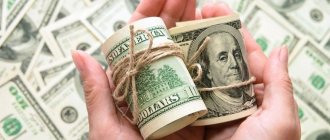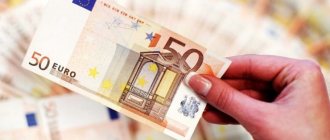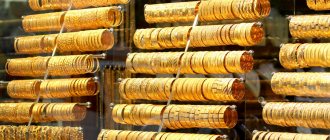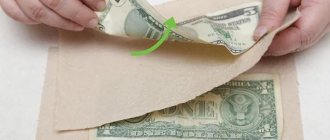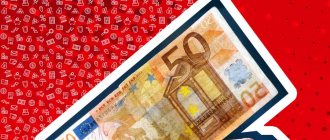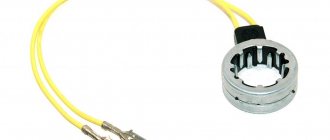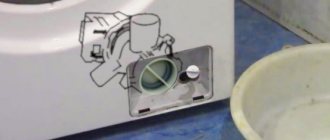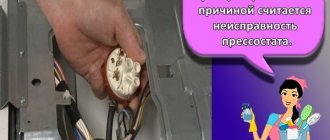People who frequently deal with foreign currencies should know how to check the authenticity of dollars. The reason for this is that counterfeit money can be found in the most unexpected places.
A particular risk arises when making large transactions when paying in cash in foreign currency.
To avoid deception, we recommend that you read this article and study information on how to distinguish a dollar from a fake.
The most popular foreign banknote is one hundred US dollars, so we will focus on this money.
What do dollars look like: description of appearance
Dollars are in circulation both within the United States and in many countries in Asia and Latin America. It is one of the most popular currencies in the world.
US banknotes with different denominations on the front and back sides.
The appearance of banknotes varies depending on the denomination. On the front side, the central place is occupied by portraits of American presidents. On the back are images of historical monuments and attributes of US statehood.
| Banknote denomination | Statesman on the obverse | Featured object on reverse |
| 1 | D. Washington | The Great Seal of the United States, which is used to authenticate government acts |
| 2 | T. Jefferson | Reproduction of the painting “Declaration of Independence” by John Trumbull |
| 5 | A. Lincoln | Abraham Lincoln Memorial in Washington DC |
| 10 | A. Hamilton | US Treasury |
| 20 | E. Jackson | The White house |
| 50 | W. Grant | Capitol |
| 100 | B. Franklin | Palace of Independence |
The most common banknotes in free circulation are 1.5, 10, 20 and 100 dollars. To quickly identify banknotes, it is advisable to remember the distinctive features of their design.
Variety of colors
The Federal Reserve Service took care of special dyes for the currency. How to check the authenticity of dollars using these paints? All the colored elements of the dollar, at the moment we are talking about a new bill, shimmer. Such structures include:
- the number 100 on the back of the bill (in the photo the structure is indicated by number 1);
- on the front side of the bill there is the number 100, located in the lower right corner (in the photo the structure is indicated by number 2);
- a bell sign located on the front side of the bill, near the bottom edge (in the photo the structure is indicated by number 3).
The photo above shows all these structures on the front side of the banknote.
What is the largest US dollar bill currently?
Until 1945, the United States printed and issued banknotes in denominations of 500, 1,000, 5,000 and 10,000 dollars. But three generations of Americans have grown up without ever seeing a single bill with denominations higher than $100.
On July 14, 1969, an order was issued that no $500, $1,000, $5,000, or $10,000 banknotes placed in Federal Reserve Banks should be put into circulation. However, these bills still remain legal tender.
According to the US Secret Service, the Treasury Department issued a $100,000 , or “gold certificate.” It has never been in circulation and is used exclusively between US Federal Reserve banks.
Serial number
The numbering on both sides of the bill must be the same, all numbers must match.
The series must be at the same level on both sides of the banknote.
The letter and number below the numbering must correspond to the order in the English alphabet (A - 1, B -2, C- 3, and so on). The letter is the branch of the Federal Reserve Bank that prints bills.
Banknotes that are most often counterfeited
Creating a high-quality fake is extremely expensive. For this reason, it is not advisable to falsify small banknotes.
In the United States, counterfeit $20 bills are the most common. They are actively used for cash payments. Large purchases are often paid for with bank cards.
Outside the United States, scammers prefer to counterfeit $100 bills. Many people have little idea what exactly such banknotes look like and how to distinguish them from counterfeits. Therefore, they are easier to distribute among tourists and local residents. At the same time, the production and sale of such banknotes brings high profits.
In 2010, a new $100 bill was presented, which has the latest levels of security. In practice, it is extremely difficult to fake. Now criminals practically do not touch her. Perhaps it's just a matter of time. However, old-style banknotes are still in use, and they are actively counterfeited.
The new $100 bill has a bluish tint, while the old one has a green tint.
The image on them is also slightly modified, different fonts are used.
Print clarity
- Always very clear print. It is printed with ink that is not commercially available. When looking at a bill through a magnifying glass, you can see even inscriptions of 100 dollars, etc. In a fake, small inscriptions will usually be blurry.
- Volumetric printing. This is done so that even a blind person can determine by touch what denomination the banknote is.
- Rough print. If you run your fingernail along the collar of B. Franklin's camisole, it will cling to the design.
The inscription “$100” on both old and new banknotes is two-color . If you look straight, you see one color (green), if you turn the banknote at an angle, the color changes (black).
It's hard to fake, so that's the first thing you should pay attention to.
If you hold the banknote up to the light, you will see:
- A security thread with an inscription on the left side of the banknote, which corresponds to the denomination of the bill. The inscription can only be read through ultraviolet light.
"Frame" of the bill
If you take a magnifying glass, you will notice that the “frame” of the bill is very clearly drawn. Fakes will not have this quality.
Banknote fibers
fibers on the back of the bill : red, blue or green. Like pieces of fabric or interspersed threads. And this fiber can be picked out with a needle. On fakes this is a painted fiber.
Checking 100 dollar bill
Since new counterfeit dollars are an exceptional phenomenon, let’s consider a more widespread forgery, that is, old-style $100 bills:
How to distinguish dollars from fakes, signs of authenticity:
- material. The paper of a real dollar is actually cloth. It rustles a little, and if the money is wet, after drying it will be normal, without defects;
- the print is three-dimensional, so a fake can be identified by touch - it is smooth;
- the inscription “100 dollars” changes color at an angle (green, black);
- run your fingernail over Franklin's camisole; on the real one, the nail clings to the design;
- all numbers on the banknote must match (but it is clear that scammers observe this when counterfeiting dollars). But sometimes they print the same numbers on a batch. If you receive several bills from someone at once, compare the numbers, they should not match;
- the protective strip is visible in the light; “USA 100” is written on it;
- The frame of the bill is clear and continuous, the ornaments are well expressed. Fakes may have some blurriness. The portrait of Franklin on real money is also clear and detailed.
If you come across a new type of banknote, then there is nothing to worry about. It's too complicated for scammers.
Some scammers target tourists specifically. They wash off the denomination on $1 or $5 bills and print “100” on it. Therefore, it is extremely important to know what exactly is depicted on the 100 dollars - Franklin.
How to spot a fake $2 bill? In fact, it is extremely rare, it can even be called a collector's item. And definitely no one will fake it. But if you are interested in it for the purpose of collecting, then in general the verification method is the same as for 100 dollars - visual.
How to distinguish a fake 50 dollar bill - everything here is also similar, to the touch, visually. If you look at the light, you will see a protective line with the inscription “USA 50”.
What denomination is most often counterfeited?
First, let's figure out what kind of banknotes are in use. If all Russians are familiar with the assortment of rubles, then with American currency everything is different. If you contact her extremely rarely, for example, only when traveling abroad, we recommend that you familiarize yourself with the denominations: these are 1, 2, 5, 10, 20 and 100 dollars.
In general, questions about how to determine a real 1 dollar almost never arise. Fraudsters are not interested in small banknotes. As they say, there is no “exhaust” from them, but a lot of fuss. Similarly, professional counterfeits of 10, 50 and 100 ruble banknotes are not found in Russia. Exceptions are those printed on a printer by some children or teenagers.
Banknotes in denominations of 20 or 50 dollars are also extremely rarely counterfeited. If you go to a country where the majority of the population lives below the poverty line, you may come across such a counterfeit. There, a 100 dollar bill is too big for the majority of the population, and selling it is not always easy. The probability of encountering counterfeits of 20 and 50 dollars is low, but it cannot be completely ruled out.
Fake 100 dollars - this is the banknote that scammers “love” most. This is what is most often counterfeited. It is not the most popular, so people are not particularly familiar with it. In addition, its sale promises good profits.
An interesting fact: at one time they even wanted to take this banknote out of circulation, since it was very often counterfeited.
Tactile sensations
In many cases, you can distinguish a fake from a genuine banknote by touch. To do this, it is useful to know what signs you should pay attention to first.
Structure
In terms of physical properties, the material from which dollars are made is more reminiscent of fabric rather than cellulose paper.
Dollar bills have high mechanical strength. They withstand exposure to water without consequences and are easily restored after being crushed. Bank notes are elastic and can stretch a little. Upon tactile examination, the material feels a little rough.
Thickness
The thickness of the banknote is less than that of the counterfeits. When making real dollars in 2022 and earlier, the paper is pressed so it is strong and thin. Counterfeiters use low quality paper. If there is a similar banknote of the same denomination and the same series and you are confident in its authenticity, you can compare them. They should be the same.
Visually, dollar bills look quite thick. However, this effect is achieved through the use of relief printing. The thickness of bank notes is actually quite small. Even the highest quality counterfeits are printed on thicker paper.
Paper
- thinner than usual. The counterfeit paper is ordinary paper made from cellulose, so it is much thicker than a real bill.
- rustles because paper is the same fabric, it consists of cotton (75%) and linen (25%);
- not afraid of water. If you wet it, then after drying it will not lose its properties, but ordinary paper becomes unusable after such a procedure.
Protective signs
Genuine dollar banknotes have a number of degrees of protection:
- Magnetic – part of the image is made using paint that has ferromagnetic properties. To check this characteristic, a special sensor is required, which is equipped with banknote detectors.
- Iris roll. It represents a gradient transition from one color to another. A home printer is not capable of simulating this effect.
- Banknote size. The dollars in circulation are 155.956 mm long and 66.294 mm wide. Deviation of no more than 2 mm in both directions is allowed.
- 3D ribbon used on $100 bills. On it you can see numbers and images of bells that move when the angle of inclination changes.
- Metallic paint. Used for printing NextGen series banknotes. On the obverse of $10, $20, and $50 tickets, to the right of the president's portrait are images of the Statue of Liberty's torch, an eagle with a shield, and a star, respectively.
- Background glow in ultraviolet. Genuine banknotes do not have this phenomenon. The paper used by scammers will glow when exposed to UV rays. At the same time, in authentic banknotes, security fibers that are embedded in the structure of the paper and a hidden thread that runs across the entire width of the banknote luminesce.
Colored "hairs"
These elements are also components of the banknote security. If you have seen dollars at least once in your life, then you have seen that the paper itself has such defective specific fibers. So, these fibers are not defective at all, but on the contrary. Thanks to these fibers, placing the bill in a special ultraviolet device, you can distinguish the authenticity of the banknote. These fibers are ultraviolet sensitive, so they glow when exposed to ultraviolet light. These hairs are visible in the photo below; it is worth noting that the color of these fibers is different: from blue to red.
Thanks to these fibers, you can provide maximum protection to American currency. The whole point is that only these fibers should glow, nothing else. If counterfeiters want to counterfeit a bill, they will not be able to precisely apply ultraviolet light; such a bill will be illuminated in the machine.
Where are counterfeit dollars sold?
Most often, they fall into the hands of tourists who have never seen dollars before or have seen them, but not so often. So if you're traveling to a country where this currency is in use, be sure to learn how to spot counterfeit dollars from real ones.
At any time you can be given a fake 50 dollars in change, and sometimes you can stumble upon a fake 100 dollars even in not entirely honest exchangers. It certainly doesn't hurt to be vigilant.
In Russia, the risk of receiving a counterfeit dollar is extremely small. If you buy currency at a bank, they definitely won’t give you a counterfeit. And if you make a transaction at a non-bank point (for example, send a money transfer in foreign currency), carefully check the change. If you receive a transfer in foreign currency, especially study all the issued bills. The cashier himself may miss the fake and unknowingly give it to you.
If you get your hands on a counterfeit dollar, if you wonder too late how to recognize a counterfeit dollar, the situation is unpleasant. You've just already lost your money. You won’t be able to sell a non-original banknote even if you want to; in Russia, stores don’t work with it.
First, go to where you received the bill from. Of course, if this is possible: sometimes people bring fakes from other countries. If the counterfeit dollar was received domestically and the damage is significant, you can contact the police. Perhaps, if the scammer is exposed, you will be able to get something back through the court. But you'll have to tinker - that's a fact.
What to do if you find counterfeit $100 bills
If you discover a counterfeit banknote, you must immediately contact law enforcement agencies. Keeping such banknotes or using them to pay for goods is strictly prohibited, since such an act is criminally punishable. A person may well be accused of possessing and distributing counterfeit money or even counterfeiting.
It is advisable to remember the person from whom the money was received. The more detailed the circumstances of receiving counterfeit money are described, the higher the likelihood of finding the attacker.
It is advisable not to touch the banknote, but immediately transfer it to a bag. This will leave the possibility of identifying counterfeiters by fingerprints.
Where can you check dollars for authenticity?
You can verify the authenticity of dollars at banking organizations. The method is highly reliable, but will require some costs, because This service is paid.
There is another convenient option for checking banknotes - visiting a representative office of a banking equipment supplier.
Equipment sellers have samples of banknote detectors in their office for demonstration purposes. Before visiting the representative office, you will need to arrange a presentation. To check the operation of the devices, you can use your own samples of banknotes, which raise doubts about the authenticity. Presentation and consultations are free of charge. Participation in the demonstration does not impose any obligations on the event participants to purchase devices.
Hologram strip
The next way to check the authenticity of dollars is a hologram. This innovation is inherent only to new banknotes. This strip was already mentioned above in the article, but now I would like to talk about it in more detail.
Firstly, this strip is made in 3D design.
The number 100 can be traced on it, which indicates the denomination of the banknote. But that's not all! This strip is transparent, which makes it possible to see the background of the bill. This hologram strip is also useful for the blind, as it has a ribbed surface, which gives it tactile properties.
